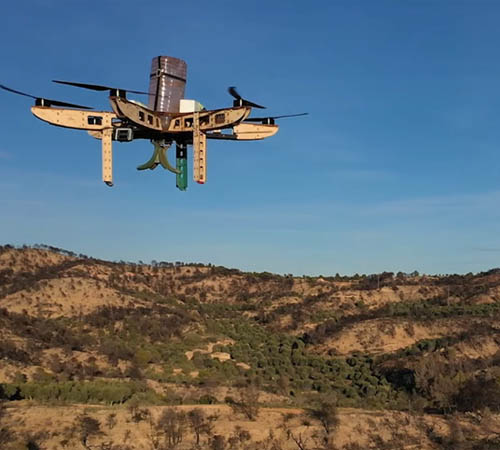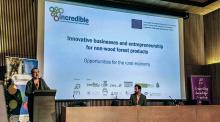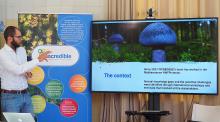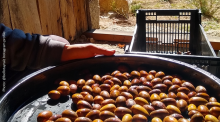Innovation from the skies: Drone technology for dispersion of pelletized seeds for reforestation

Dronecoria, founded by Lot Amorós of Elche, Spain, is applying drone technology for dispersion of pelletized seeds for reforestation. He and his team were awarded $20,000 for their innovative development of a seed-coating method, which is critical for their approach to large scale, low-cost direct sowing of native seeds for ecosystem restoration.
Conservation X Labs is a US-based technology and innovation company that “spurs innovative solutions to stop the extinction crisis by harnessing genius solutions” from all over our planet.
Mr. Amorós who presented his project at the cross-cutting seminar Innovative Businesses and Entrepreneurship in Non-Wood Forest Products, 27 and 28 February 2020 in Barcelona, brought one of his light-weight and open-source drone models designed for the dispersion of seeds for global reforestation. Among the challenges they face is the design of the seed coat that must offer both protection from the elements and predators, and help provide nutrition for emerging seedlings.
As he explained, the technology of seed coating is complex and highly guarded in the agri-food sector. Their goal is to formulate ingredients and methods that are reliable and open sourced for world-wide, low-cost application in direct seeding of many plant and tree species for reforestation. This will reduce costs and limitations associated with transplanting of container seedlings, and open up possibilities for landscape level restoration beyond monoculture plantations.
The “Powerful Seeds” approach incorporates three basic technologies: 1) Priming, 2) Seed Coating and 3) Mycorrhizal Inoculation to support plant fungal symbiosis at the time of germination.
Priming of seeds to improve germination is being carried out by Daniel Calatayud of Semillistas in Granada. He experiments with priming techniques using many native seeds from the region. His work demonstrates that priming of seeds prior to direct sowing can prepare them for emergence even when rainfall is scarce. Unreliable germination and emergence are serious obstacles to direct seeding. More than 10,000 seeds were planted in the autumn of 2020 and germination has begun.
For the 2020 pilot project in the Sierra de Lujár of Andalusia, the mycorrhizal inoculations were coordinated by Christine Fischer of CTFC. Within the seed coats of Quercus seeds, spores of the summer truffle Tuber aestivum have been included. Truffle experts from La Rioja, Navarra, Soria and Catalonia have assisted in collection of truffles this past summer. Seedling survival and mycorrhizal status will be evaluated over this coming year. Stay tuned!















 ‘Innovation Networks of Cork, Resins and Edibles in the Mediterranean basin’ (INCREDIBLE) project receives funding from the European Commission’s Horizon 2020 programme under grant agreement Nº 774632
‘Innovation Networks of Cork, Resins and Edibles in the Mediterranean basin’ (INCREDIBLE) project receives funding from the European Commission’s Horizon 2020 programme under grant agreement Nº 774632
Comments (26477)
free chatting online dating sites
[url="https://onlinedatinghunks.com"]website dating service[/url]
free online chatting and dating
ourtime login
[url="https://onlinedatingsuccessguide.com"]japanese dating sites[/url]
dating singles site
matchmaking dating
[url="https://onlinedatingsuccessguide.com"]free dating siwomen[/url]
free dating chatting online
free adult date sites
[url="https://onlinedatingsuccessguide.com"]free dating sites chat[/url]
find free dating site
dating near me free
[url="https://onlinedatingsuccessguide.com"]relationship website[/url]
dating sinulator online
casual dating sites
[url="https://onlinedatingsuccessguide.com"]dating gmail germany[/url]
meet european singles in usa
adult dating married
[url="https://onlinedatingsuccessguide.com"]singles to meet[/url]
singles and personals
top free dating sites
[url="https://onlinedatingsuccessguide.com"]free sites sites[/url]
free date web sites
tinder web
[url="https://onlinedatingsuccessguide.com"]single ladies[/url]
singles near me
free dating site for ladys
[url="https://onlinedatingsuccessguide.com"]meet singles[/url]
free gay dating sites chat
free dating service
[url="https://onlinedatingsuccessguide.com"]meet local singles free[/url]
online dejting
free online dating service
[url="https://onlinedatingsurvey.com"]our time dating[/url]
absolutely free dating site
good free dating sites
[url="https://onlinedatingsurvey.com"]dating sites that are totally free[/url]
find single women
pof dating site
[url="https://onlinedatingsurvey.com"]meet single women[/url]
share dating
free free online dating
[url="https://onlinedatingsurvey.com"]ourtime free trial[/url]
relative dating
christian singles dating site
[url="https://onlinedatingsurvey.com"]asian dating[/url]
good dating websites
pof dating site
[url="https://onlinedatingsurvey.com"]single woman dating for free[/url]
online dating sites free chatting
online dating site
[url="https://onlinedatingsurvey.com"]online dejting[/url]
bbw dating
free date sites
[url="https://onlinedatingsurvey.com"]senior dating[/url]
topchatsites
share dating
[url="https://onlinedatingsurvey.com"]dating websites free[/url]
adult-daiting site
meet women for free online
[url="https://onlinedatingsurvey.com"]adult date site[/url]
zoosk login
online site
[url="https://sexanddatingonline.com"]christian dating sites[/url]
totally free chat dating site
plenty of fish dating site of free dating
[url="https://sexanddatingonline.com"]faroedating chat[/url]
popular dating sites
chat singles
[url="https://sexanddatingonline.com"]a free dating site[/url]
adult chat free
catholic christian dating website
[url="https://sexanddatingonline.com"]online dating sites for free 100%[/url]
dafing sites
our time dating website
[url="https://sexanddatingonline.com"]adult chat free[/url]
free online
online dating sites free chatting
[url="https://sexanddatingonline.com"]online marriage sites in usa[/url]
free online chatting and dating
singles dating sites
[url="https://sexanddatingonline.com"]singles to meet[/url]
dating online chat and meet
date sex
[url="https://sexanddatingonline.com"]free dating sites women[/url]
senior bi log in
plenty of fish dating site
[url="https://sexanddatingonline.com"]meet older women for free[/url]
dating site sign up
facebook dating site
[url="https://sexanddatingonline.com"]dating service websites[/url]
mature nl free
I have been looking for articles on these topics for a long time. 바카라사이트 I don't know how grateful you are for posting on this topic. Thank you for the numerous articles on this site, I will subscribe to those links in my bookmarks and visit them often. Have a nice day.
как дышать при панической атаке
Fantastic job! Very informative. Keep it up! Go check out this website too: Click me
Hey! This is excellent! You can also try visiting this site. Click me!
This article has so much amazing information. <a href=" https://srislawyer.com/abogado-divorcio-sin-oposicion-virginia-cronologia-divorcio-sin-oposicion-va/ ">Visit divorcio de mutuo acuerdo en virginia </a>
https://nakrutkavktop.ru/ - накрутить участников в группу вк
https://nakrutkavktop.ru/ - онлайн накрутка лайков в вк
https://nakrutkavktop.ru/ - накрутить друзей вк бесплатно
https://nakrutkavktop.ru/ - получить лайки в вк
https://nakrutkavktop.ru/ - накрутка лайков в вк бесплатно с заданиями
https://nakrutkavktop.ru/ - взаимное голосование
free online dating service
[url="https://allaboutdatingsites.com"]best dating websites free[/url]
eu mature
100% free dating site in europe
[url="https://allaboutdatingsites.com"]flirt singles[/url]
our time dating
dateing websites
[url="https://allaboutdatingsites.com"]fb dating[/url]
bbw dating
sexy dating apps
[url="https://allaboutdatingsites.com"]asian girl single[/url]
vip dating now
dating top sites
[url="https://allaboutdatingsites.com"]dating free chating[/url]
dating free site online
dating direct
[url="https://allaboutdatingsites.com"]online marriage sites in usa[/url]
free local dating sites
https://nakrutkavktop.ru/ - получить лайки в вк
https://nakrutkavktop.ru/ - накрутка лайков в вк бесплатно с заданиями
https://nakrutkavktop.ru/ - взаимное голосование
local singles in my area
[url="https://allaboutdatingsites.com"]senior dating sites free[/url]
dating web site
romancemingle
[url="https://allaboutdatingsites.com"]plenty of fish dating site[/url]
matchmaking services melbourne
https://nakrutkavktop.ru/ - как быстро накрутить подписчиков в вк
https://nakrutkavktop.ru/ - лайки на вк
https://nakrutkavktop.ru/ - накрутка подписчиков в паблик вк
https://nakrutkavktop.ru/ - получить лайки в вк
https://nakrutkavktop.ru/ - накрутка лайков в вк бесплатно с заданиями
https://nakrutkavktop.ru/ - взаимное голосование
online free
[url="https://allaboutdatingsites.com"]personal ads dating[/url]
local personals
Pages
Add Comment